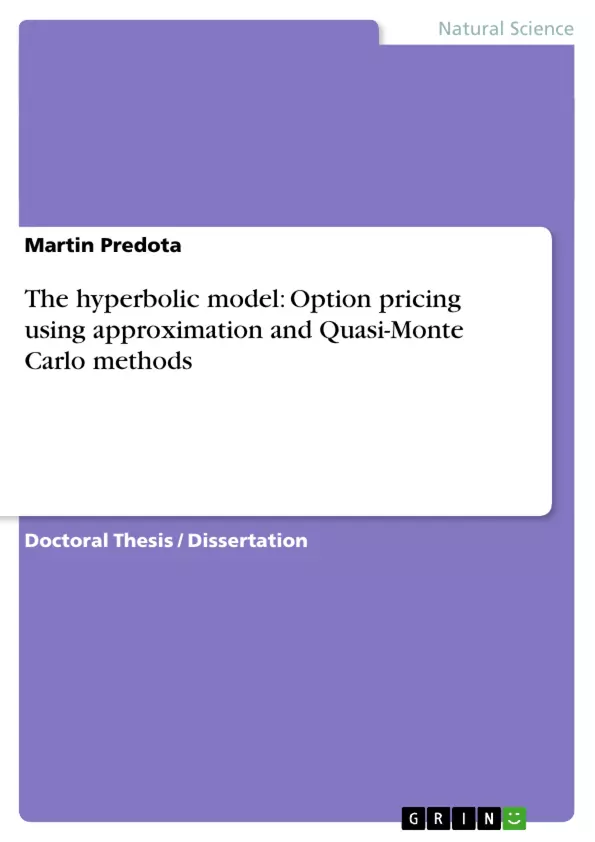Aus Sicht der Mathematik spielen Optionen eine wesentliche Rolle seit der bahnbrechenden Arbeit von Black und Scholes im Jahre 1973. Deren Modell basiert jedoch auf der unrealistischen Annahme, das log-returns von Aktienkursen normalverteilt sind. Eberlein und Keller haben 1995 gezeigt, daß solche log-returns hyperbolisch verteilt sind. Die vorliegende Arbeit baut auf dieser Annahme auf und erweitert das Optionsspektrum von Europäischen Optionen auf Asiatische, Amerikanische sowie Multi-Asset-Optionen. Weiters wird das "Standard"-Martingal-Maß, die sogenannte Esscher-Transformation, durch das Entropie-minimierende Maß erweitert. Da jedoch keine exakte Preissetzung solcher Optionen möglich ist, wird auf numerische Simulationen und Approximationen zurückgegriffen. Die verwendeten numerischen Verfahren sind die Monte Carlo-Methode mit verschiedenen Varianzreduktionstechniken und die Quasi-Monte Carlo Methode.
Inhaltsverzeichnis (Table of Contents)
- Chapter 1: Hyperbolic Lévy processes
- 1.1 Introduction
- 1.2 Lévy processes
- 1.3 Infinitely divisible distributions
- 1.4 The generalized hyperbolic distribution
- 1.4.1 The hyperbolic distribution
- 1.4.2 Asymptotic ML-estimators
- 1.4.3 Approximating the inverse distribution function
- 1.4.4 The NIG distribution
- 1.5 The loghyperbolic distribution
- 1.6 The hyperbolic Lévy motion
- 1.6.1 NIG processes
- 1.6.2 Changing measures
- Chapter 2: Option pricing and Quasi-Monte Carlo methods
- 2.1 Introduction
- 2.2 Basic concepts of option pricing
- 2.2.1 The Black-Scholes model
- 2.2.2 The generalized hyperbolic model
- 2.3 Monte Carlo methods and variance reduction
- 2.3.1 Variance reduction techniques
- 2.4 Quasi-Monte Carlo methods
- Chapter 3: Asian options
- 3.1 Introduction
- 3.2 Options on the general mean
- 3.3 Approximation of arithmetic average options
- Chapter 4: Asian option pricing in the NIG model
- 4.1 Introduction
- 4.2 Stop-loss transforms and upper bounds for arithmetic average options
- 4.3 Approximations for arithmetic average options
- 4.4 Arithmetic and geometric average options
- 4.5 Comparison with the Black-Scholes-model
- Chapter 5: American options
- 5.1 Introduction
- 5.2 American option pricing
- 5.3 Bundling algorithm
- 5.4 Simulated Tree Algorithm
- Chapter 6: The minimal entropy martingale measure
- 6.1 Introduction
- 6.2 Lévy processes and the minimal entropy martingale measure
- 6.3 The minimal entropy martingale measure for NIG Lévy processes
- 6.4 Option pricing
- Chapter 7: Options on several assets
- 7.1 Introduction
- 7.2 The d-dimensional hyperbolic distribution
- 7.3 Option pricing
Zielsetzung und Themenschwerpunkte (Objectives and Key Themes)
This dissertation generalizes the results of Eberlein and Keller's 1995 hyperbolic model for option pricing, extending it beyond standard European options. It investigates the application of approximation and Quasi-Monte Carlo methods for pricing various option types within this framework.
- Properties of Lévy processes and infinitely divisible distributions, particularly the generalized hyperbolic distribution.
- Application of Monte Carlo and Quasi-Monte Carlo methods for option pricing.
- Pricing of Asian options (arithmetic, geometric, and general mean) within the hyperbolic and NIG models.
- Development and comparison of algorithms for pricing American and Bermudan options.
- Exploration of alternative martingale measures, such as the minimal entropy martingale measure, for option pricing.
Zusammenfassung der Kapitel (Chapter Summaries)
Chapter 1 introduces the fundamental properties of Lévy processes and infinitely divisible distributions, focusing on the generalized hyperbolic distribution and its relevance in financial modeling. Chapter 2 provides an overview of option pricing, comparing the Black-Scholes and hyperbolic models, and introduces Monte Carlo and Quasi-Monte Carlo methods. Chapter 3 explores the pricing of Asian options using Monte Carlo and Quasi-Monte Carlo simulations within the hyperbolic model. Chapter 4 focuses on Asian option pricing within the NIG model, deriving upper bounds and approximations for arithmetic and geometric average options, and comparing results with the Black-Scholes model. Chapter 5 details algorithms for simulating American and Bermudan option prices in the hyperbolic and NIG models.
Schlüsselwörter (Keywords)
Hyperbolic model, option pricing, Lévy processes, infinitely divisible distributions, generalized hyperbolic distribution, normal inverse Gaussian (NIG) distribution, Monte Carlo methods, Quasi-Monte Carlo methods, Asian options, American options, Esscher transform, minimal entropy martingale measure, multi-asset options.
- Citar trabajo
- Dr. Martin Predota (Autor), 2002, The hyperbolic model: Option pricing using approximation and Quasi-Monte Carlo methods, Múnich, GRIN Verlag, https://www.grin.com/document/125316



